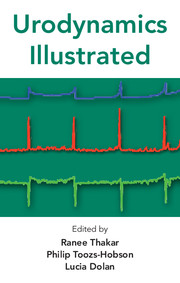Book contents
- Frontmatter
- Contents
- About the authors
- Acknowledgements
- Glossary and abbreviations
- Preface
- 1 Introduction
- 2 Setting up the equipment
- 3 Flow rate testing
- 4 Cystometry
- 5 Videocystourethrography
- 6 Ambulatory urodynamic monitoring
- 7 Urodynamic artefacts
- 8 Assessment of urethral function
- 9 Bladder diaries
- 10 Pad testing
- 11 Pre-test assessment using questionnaires
- 12 Ultrasound as a tool in urodynamics
- Index
Preface
Published online by Cambridge University Press: 05 February 2014
- Frontmatter
- Contents
- About the authors
- Acknowledgements
- Glossary and abbreviations
- Preface
- 1 Introduction
- 2 Setting up the equipment
- 3 Flow rate testing
- 4 Cystometry
- 5 Videocystourethrography
- 6 Ambulatory urodynamic monitoring
- 7 Urodynamic artefacts
- 8 Assessment of urethral function
- 9 Bladder diaries
- 10 Pad testing
- 11 Pre-test assessment using questionnaires
- 12 Ultrasound as a tool in urodynamics
- Index
Summary
This book provides concise information to help clinicians who are new to urodynamics as well as acting as an aide memoire for established practitioners. It was born out of the recognised need for a manual that can be an instant reference for practitioners. The book follows many of the key principles taught on the joint Royal College of Obstetricians and Gynaecologists and British Society of Urogynaecology Urodynamics Course and uses the Minimum Standards in Urodynamics document and the International Continence Society standards as the main underpinning documentation for the text.
We cannot overstate the importance of the expertise of the observer when attempting to obtain accurate and reliable measurements when performing urodynamics. Good urodynamic practice occurs when there is a clear urodynamic question, adequate patient preparation, appropriate technical expertise and an interactive test. In this book, we provide both a technical and clinical guide for the urodynamics observer through illustration of many of the practical steps and common clinical observations reported in the urodynamics laboratory. Several urodynamic investigations are discussed, ranging from the basic tests such as uroflowmetry and subtracted cystometry to the more complex namely videocystometry, ambulatory monitoring and urethral function tests. The key principles of measurement of physiological and pathophysiological parameters of lower urinary tract function are common, irrespective of type of investigation. This book should provide the core knowledge to undertake these measurements and an understanding of their limitations.
- Type
- Chapter
- Information
- Urodynamics Illustrated , pp. xv - xviPublisher: Cambridge University PressPrint publication year: 2011



